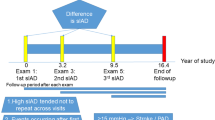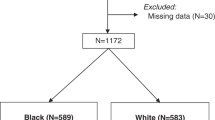Abstract
Raised blood pressure (BP) causes pathophysiological cardiovascular changes resulting in target organ damage. Although ambulatory and central BP relate more strongly to outcomes than clinical brachial BP in the elderly population, it is unknown which measure of BP is most strongly associated with markers of organ damage in younger populations. We compared the strength of associations between different BPs and measures of subclinical organ damage and investigated whether ethnic differences exist between these associations. The design was a cross-sectional analysis of the African-PREDICT study, including young black and white men and women (aged 20–30, N = 1202). We obtained clinic, ambulatory, and central BP readings, as well as measures of subclinical organ damage: central retinal arteriolar equivalent (CRAE) from fundus images, echocardiography to determine left ventricular mass index (LVMi), carotid intima media thickness (CIMT), carotid-femoral pulse wave velocity (PWV), and albumin-to-creatinine ratio (ACR) determined from spot urine samples. Overall, weak correlations were evident between CIMT, ACR, and BP, whereas CRAE, LVMi, and PWV correlated strongly with BP. In the total group, clinic brachial BP had stronger associations with CRAE, LVMi, and PWV (all p < 0.001) than ambulatory and central BP. Although the ethnic groups showed similar correlations between CRAE, LVMi, CIMT, and the various BPs, PWV correlated more strongly with ambulatory systolic BP (p < 0.001) in white participants. In young healthy adults, clinic brachial BP correlated more strongly with measures of early target organ damage than central or ambulatory BP. No differences were observed between correlations of BP and measures of target organ damage in the two ethnic groups.
This is a preview of subscription content, access via your institution
Access options
Subscribe to this journal
Receive 12 print issues and online access
$259.00 per year
only $21.58 per issue
Buy this article
- Purchase on Springer Link
- Instant access to full article PDF
Prices may be subject to local taxes which are calculated during checkout


Similar content being viewed by others
References
Stanaway JD, Afshin A, Gakidou E, Lim SS, Abate D, Abate KH, et al. Global, regional, and national comparative risk assessment of 84 behavioural, environmental and occupational, and metabolic risks or clusters of risks for 195 countries and territories, 1990-2017: a systematic analysis for the Global Burden of Disease Study 2017. Lancet. 2018;392:1923–94.
Schmieder RE. End organ damage in hypertension. Dtsch Arztebl Int. 2010;107:866–73.
Cuspidi C, Meani S, Salerno M, Fusi V, Severgnini B, Valerio C, et al. Retinal microvascular changes and target organ damage in untreated essential hypertensives. J Hypertens. 2004;22:2095–102.
Laurent S, Boutouyrie P. The structural factor of hypertension: large and small artery alterations. Circ Res. 2015;116:1007–21.
Mustafa ER, Isratoaie O, Musetescu R. Blood pressure variability and left ventricular mass in hypertensive patients. Curr Health Sci J. 2016;42:47–50.
Pedrinelli R, Dell’Omo G, Di Bello V, Pontremoli R, Mariani M. Microalbuminuria, an integrated marker of cardiovascular risk in essential hypertension. J Hum Hypertens. 2002;16:79–89.
Stehouwer CD, Smulders YM. Microalbuminuria and risk for cardiovascular disease: analysis of potential mechanisms. J Am Soc Nephrol. 2006;17:2106–11.
Vischer AS, Burkard T. Principles of blood pressure measurement—current techniques, office vs ambulatory blood pressure measurement. Adv Exp Med Biol. 2017;956:85–96.
Head GA. Ambulatory blood pressure monitoring is ready to replace clinic blood pressure in the diagnosis of hypertension. Hypertension. 2014;64:1175–81.
Shahab H, Khan HS, Almas A, Tufail M, Kazmi KA, Khan AH. The post clinic ambulatory blood pressure (PC-ABP) study correlates post clinic blood pressure (PCBP) with the gold standard ambulatory blood pressure. BMC Res Notes. 2018;11:460.
Shimbo D, Abdalla M, Falzon L, Townsend RR, Muntner P. Role of ambulatory and home blood pressure monitoring in clinical practice: a narrative review. Ann Intern Med. 2015;163:691–700.
Staessen JA, Li Y, Hara A, Asayama K, Dolan E, O’Brien E. Blood pressure measurement anno 2016. Am J Hypertens. 2017;30:453–63.
Drawz PE, Abdalla M, Rahman M. Blood pressure measurement: clinic, home, ambulatory, and beyond. Am J Kidney Dis. 2012;60:449–62.
McEniery CM, Cockcroft JR, Roman MJ, Franklin SS, Wilkinson IB. Central blood pressure: current evidence and clinical importance. Eur Heart J. 2014;35:1719–25.
Middeke M. Central aortic blood pressure: important parameter in diagnosis and therapy. Dtsch Med Wochenschr. 2017;142:1430–6.
Franklin SS, Khan SA, Wong ND, Larson MG, Levy D. Is pulse pressure useful in predicting risk for coronary heart disease? The Framingham Heart Study. Circulation. 1999;100:354–60.
Wilkinson IB, Franklin SS, Cockcroft JR. Nitric oxide and the regulation of large artery stiffness: from physiology to pharmacology. Hypertension. 2004;44:112–6.
Banegas JR, Ruilope LM, de la Sierra A, Vinyoles E, Gorostidi M, de la Cruz JJ, et al. Relationship between Clinic and ambulatory blood-pressure measurements and mortality. N Engl J Med. 2018;378:1509–20.
Eguchi K. Ambulatory blood pressure monitoring in diabetes and obesity-a review. Int J Hypertens. 2011;2011:954757.
White WB, Jalil F, Wakefield DB, Kaplan RF, Bohannon RW, Hall CB, et al. Relationships among clinic, home, and ambulatory blood pressures with small vessel disease of the brain and functional status in older people with hypertension. Am Heart J. 2018;205:21–30.
Williams B, Mancia G, Spiering W, Agabiti Rosei E, Azizi M, Burnier M, et al. 2018 ESC/ESH Guidelines for the management of arterial hypertension. Eur Heart J. 2018;39:3021–104.
Schutte AE, Botha S, Fourie CMT, Gafane-Matemane LF, Kruger R, Lammertyn L, et al. Recent advances in understanding hypertension development in sub-Saharan Africa. J Hum Hypertens. 2017;31:491–500.
Muntner P, Abdalla M, Correa A, Griswold M, Hall JE, Jones DW, et al. Hypertension in Blacks: unanswered questions and future directions for the Jackson Heart Study. Hypertension. 2017;69:761–9.
Mezue K, Isiguzo G, Madu C, Nwuruku G, Rangaswami J, Baugh D, et al. Nocturnal non-dipping blood pressure profile in Black normotensives is associated with cardiac target organ damage. Ethn Dis. 2016;26:279–84.
Abdalla M, Caughey MC, Tanner RM, Booth JN, Diaz KM, Anstey DE, et al. Associations of blood pressure dipping patterns with left ventricular mass and left ventricular hypertrophy in Blacks: the Jackson Heart Study. Am Heart J. 2017;6:e004847.
Drazner MH, Dries DL, Peshock RM, Cooper RS, Klassen C, Kazi F, et al. Left ventricular hypertrophy is more prevalent in blacks than whites in the general population: the Dallas Heart Study. Hypertension. 2005;46:124–9.
Kriel JI, Fourie CMT, Schutte AE. Monocyte chemoattractant protein-1 and large artery structure and function in young individuals: the African-PREDICT study. J Clin Hypertens. 2017;19:67–74.
Schutte AE, Gona PN, Delles C, Uys AS, Burger A, Mels CM, et al. The African prospective study on the early detection and identification of cardiovascular disease and hypertension (African-PREDICT): design, recruitment and initial examination. Eur. J Prev Cardiol. 2019;26:458–70.
Barna I, Keszei A, Dunai A. Evaluation of Meditech ABPM-04 ambulatory blood pressure measuring device according to the British Hypertension Society protocol. Blood Press Monit .1998;3:363–8.
Knudtson MD, Lee KE, Hubbard LD, Wong TY, Klein R, Klein BE. Revised formulas for summarizing retinal vessel diameters. Curr Eye Res. 2003;27:143–9.
Devereux RB, Alonso DR, Lutas EM, Gottlieb GJ, Campo E, Sachs I, et al. Echocardiographic assessment of left ventricular hypertrophy: comparison to necropsy findings. Am J Cardiol. 1986;57:450–8.
Van Bortel LM, Laurent S, Boutouyrie P, Chowienczyk P, Cruickshank JK, De Backer T, et al. Expert consensus document on the measurement of aortic stiffness in daily practice using carotid-femoral pulse wave velocity. J Hypertens. 2012;30:445–8.
Williams EJ. The comparison of regression variables. J R Stat Soc Ser B Stat Methodol. 1959;21:396–9.
Chi C, Yu X, Auckle R, Lu Y, Fan X, Yu S, et al. Hypertensive target organ damage is better associated with central than brachial blood pressure: the Northern Shanghai Study. J Clin Hypertens. 2017;19:1269–75.
Woodiwiss AJ, Molebatsi N, Maseko MJ, Libhaber E, Libhaber C, Majane OH, et al. Nurse-recorded auscultatory blood pressure at a single visit predicts target organ changes as well as ambulatory blood pressure. J Hypertens. 2009;27:287–97.
Dadlani A, Madan K, Sawhney JPS. Ambulatory blood pressure monitoring in clinical practice. Indian Heart J. 2019;71:91–7.
Fisher JP, Paton JFR. The sympathetic nervous system and blood pressure in humans: implications for hypertension. J Hum Hypertens. 2012;26:463–75.
Mokwatsi GG, Schutte AE, Kruger R. Ethnic differences regarding arterial stiffness of 6–8-year-old black and white boys. J Hypertens. 2017;35:960–7.
Mitchell P, Cheung N, de Haseth K, Taylor B, Rochtchina E, Islam FMA, et al. Blood pressure and retinal arteriolar narrowing in children. Hypertension. 2007;49:1156–62.
Cokkinos DV, Belogianneas C. Left ventricular remodelling: a problem in search of solutions. Eur Cardiol. 2016;11:29.
Jarauta E, Mateo-Gallego R, Bea A, Burillo E, Calmarza P, Civeira F. Carotid intima-media thickness in subjects with no cardiovascular risk factors. Rev Esp Cardiol. 2010;63:97–102.
Takase H, Sugiura T, Ohte N, Dohi Y. Urinary albumin as a marker of future blood pressure and hypertension in the general population. Medicine. 2015;94:e511.
Schultz AJ, Schutte AE, Schutte R. Double product and end-organ damage in African and Caucasian men: the SABPA study. Int J Cardiol. 2013;167:792–7.
Acknowledgements
The authors are grateful toward all individuals who participated voluntarily in the study. The dedication of the support and research staff as well as students at the Hypertension Research and Training Clinic at the North-West University is also duly acknowledged. The research funded in this paper is part of an ongoing research project financially supported by the South African Medical Research Council (SAMRC) with funds from National Treasury under its Economic Competitiveness and Support Package, the South African Research Chairs Initiative (SARChI) of the Department of Science and Technology and National Research Foundation (NRF) of South Africa (GUN 86895), SAMRC with funds received from the South African National Department of Health, GlaxoSmithKline R&D (Africa Non-Communicable Disease Open Lab grant), the UK Medical Research Council, and with funds from the UK Government’s Newton Fund, as well as corporate social investment grants from Pfizer (South Africa), Boehringer-Ingelheim (South Africa), Novartis (South Africa), the Medi Clinic Hospital Group (South Africa), and in kind contributions from Roche Diagnostics (South Africa). Any opinion, findings, and conclusions or recommendations expressed in this material are those of the authors, and therefore, the NRF does not accept any liability in this regard.
Author information
Authors and Affiliations
Corresponding author
Ethics declarations
Conflict of interest
The authors declare that they have no conflict of interest.
Additional information
Publisher’s note Springer Nature remains neutral with regard to jurisdictional claims in published maps and institutional affiliations.
Supplementary information
Rights and permissions
About this article
Cite this article
Botha, D., Breet, Y. & Schutte, A.E. Comparing the associations of clinic vs. ambulatory blood pressure with subclinical organ damage in young healthy adults: the African-PREDICT study. Hypertens Res 44, 840–849 (2021). https://doi.org/10.1038/s41440-021-00627-z
Received:
Revised:
Accepted:
Published:
Issue Date:
DOI: https://doi.org/10.1038/s41440-021-00627-z
Keywords
This article is cited by
-
Hypertension and its complications are also common in low-resource specialty clinics
Hypertension Research (2023)



